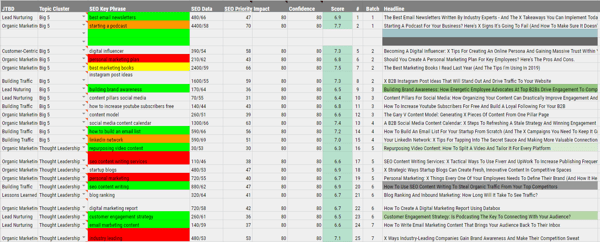When was the last time you wrote 2,000 words in an hour? Recorded ten minutes of video in a single take?
For most of us, never. Creating content faster is only a dream.
There's an assumption that anyone creating that fast is producing trash. The content is vomited into the production pipeline, and it'll take hours of editing to make it useable.
But, if you can unlock that golden door where you're producing enough value-packed content that your audience is continually satisfied, yet craving more, you'll take your brand to new heights.
And while the task may seem daunting, you can produce more content in a fraction of the time by following these ten proven techniques.
Create Content Faster While Increasing Performance
Quality content is what matters.
Google is continually crawling your pages, searching for valuable content. If everyone bounces from your site because they can't find that value either, your search rankings are going to plummet.
So, while you may want to create faster, just to have more content across your site, understand that the benefits of sheer quantity are more insignificant than you may think. But, if that quantity is overloaded with value, we have a different story.
1. Have a Running List of Content Ideas
The first step in creating faster is knowing what you're going to be working on.
Brian Tracy claims that working from a list gives an instant 25% productivity boost. Doing this will cut out all the "wondering" of what to create, and let you focus 100% on execution.
Many marketers sit down in front of the blank screen and contemplate what's worth creating. Next thing you know, it's closing time, and that screen is as bare as it was when you started.
To stop this from happening, it's a good idea to do all the brainstorming for content within your topic clusters at once, so you can just pick a title and get to work. Keyword research can use up a lot of brainpower that's better spent on creating the content you should be focused on.
We recommend you build out a 90-day strategy in one fell swoop. If you need to make changes later, that's fine, but allot time specifically for that.
Another useful trick is to keep a headline swipe file handy for quickly generating ideas. Or, if an idea strikes you, jot it on a note pad or in an Evernote folder for later.
Knowing what you're going to produce before you start goes a long way in making you more efficient.
2. Have a Framework
No matter what type of content you're producing, if you have a framework, it becomes that much easier.
For example, at Lean Labs, we format blog content with a Hook, Transition, and Thesis, followed by an H2 tag, then as many H3s as necessary to finish the article.
When I sit down to start work, I can look at this shell and my mind immediately starts firing in writing-mode. It helps the entire team produce significantly faster because we know what to expect.
Then, when we hit the editing stage and our articles are passed to another marketer, they're already familiar with the layout as well, making it easier for them to understand the intent behind our work.
Having a concrete system is essential to producing faster. If you don't want an actual framework because you feel restricted, create a to-do list for the workflow. Then, when you sit down, you'll know which order to tackle the material until it becomes second nature.
3. Research Before You Create
When you start the creation process, you want to focus solely on that. That means jumping around between your text editor and tabs on your browser should be out of the question. It breaks the flow of writing and can't let your brain hone in on the task. This holds a similar effect to multitasking, even if you're just moving back and forth between windows.
The research and outline phase should come separate from creating the content. This lets you learn everything you need before creating, stopping you from having to change gears midway through a piece.
Outlines for your articles and scripts should be as thorough as you can make them, so when you start writing, you're able to work all the way through without any major hang-ups. If there are, you can always highlight a word or phrase and come back to it later.
This will keep your mind in a "right-brained" manner of thinking and allow those creative juices to flow.
4. Create in Batches
Since you want to create as fast as possible, you should take every precaution not to break the flow of creating. An effective way to do this is by batching your content.
For our clients' blogs, we batch four articles together. While this has numerous benefits, it also gives the Inbound team a chance to spend the day writing and not half-focused on other tasks.
If your schedule permits, create content further ahead of due dates. This allows you to let loose on the first draft, worrying less about the fine details and more about providing valuable content. Since you'll have additional time for the editing phase, there's no worry that you'll miss a deadline because you'll still have a copy edit in the works.
In the same vein, don't edit as you create. Produce all the raw content first, then start your corrections. Whether it's writing, video, or graphic design, if you have the complete material to work with, editing will be much easier and faster.
5. Focus on the Topic
You make a promise in your headline. Try not to stray from that.
With customer-centric marketing, you're trying to provide as much value as possible to help the consumer through the buyer's journey. That can make whittling down your content to a core focus challenging.
Many times content will have a useful aside, but when the material is already becoming too lengthy for people to stay engaged, you're sacrificing quality.
Adding valuable information is fine, but there's nothing wrong with saving it for a separate article or adding an internal link to reference elsewhere on your site.
If you ask yourself, "How will this deliver on the headline's promise," you'll find this to be a non-issue.
6. Track Your Habits
Marketers live for data, right? Well, if you can monitor specific data about your habits, you can enhance your performance.
When you start creating, you want to track these four things:
- Your Location
- Time of Day
- Your Knowledge of the Topic
- Your Motivation Level (we call it 'Mojo')
By having a bearing on this information, you'll soon learn which locations work and don't work for you. The time of day works the same way. Some people prefer writing in the morning, others feel more creative at night. The only way to know for sure is by tracking it.
If you find content creation slower when you're less knowledgeable about the topic, you can adjust your outlines to provide more detail on challenging material.
And let's be honest, some days are just more difficult than others to motivate yourself. Keeping tabs on your motivation level will give insights into which days you can write off because they were rougher than others, or it may be enough for you to look at other habits and optimize your life.
7. Take Breaks
One of the hardest parts of working, specifically when you love your job, is taking a break. Most of us are guilty of working tirelessly at a task because we want to see its success, but we fail to realize our productivity has been decreasing in the process.
Tactics like the Pomodoro technique are great for balancing your work to break ratio. With Pomodoro, you spend 25 minutes working, five on break. Yes, the break seems short, but it's enough for a bathroom break, a glass of water, or some air squats by your desk. It's just enough to break up the monotony of working and helps to keep your mind sharp.
Pomodoro timers can be set to varying lengths of time, so you can test what works best for you to optimize your time spent working.
8. Use Editing Tools
Once you've got the content down, it's time for editing, and if you followed our advice and let loose on your creative side, there's going to be a lot to correct.
After a content edit, we recommend running your articles or video scripts through tools like Grammarly and the Hemingway App to find the more significant mistakes fast.
These tools aren't perfect, but they catch a lot of the easy stuff, making it significantly faster to get through. And once that's complete, all you need is a copyedit on your own before the content is ready for a final review.
9. Increasing Your Resources
At some point, you're going to hit a wall. There's only so much content you can produce in a week before you sacrifice value.
You have two options. You can adjust your priorities and allocate more time for writing and accept risk on other tasks, or you can increase your budget and hire more members to your team. The latter can also be done by outsourcing through platforms like Upwork.
No matter what your choice, it's important to remember when goal setting that there are only so many hours in the day, and if you don't have the means to produce what you're aiming for, you may need to scale back.
10. Repurpose Content
There is one other way you can speed up your content creation, and it may the most valuable addition to your kit.
Repurposing is your way of taking one awesome piece of content and turning it into 30.
If you're only creating one piece at a time, you're bottlenecking yourself. You're limiting what consumers can see. If you become a master of repurposing, though, you're exponentially increasing the content you can offer.
With repurposing, that one article becomes a video. It becomes social posts. It's used in email campaigns and webinars. There are endless possibilities when it comes to repurposing, and it cuts the creation process to a fraction of the time.
Creating faster isn't the only thing that's important, if you can learn to maximize the mileage of what you do create, you can provide far more value to your audience.
Reaching Max Output
While you should always strive for better efficiency, you need to keep the value of your content high. That's the reason people are coming to your site. And even if you have more content to potentially rank, none of it will because it won't be worth reading.
If you do hit a wall and find you can't produce more, you don't need to hesitate for a new strategy. You can pull older content and bring it back to life by repurposing it.







